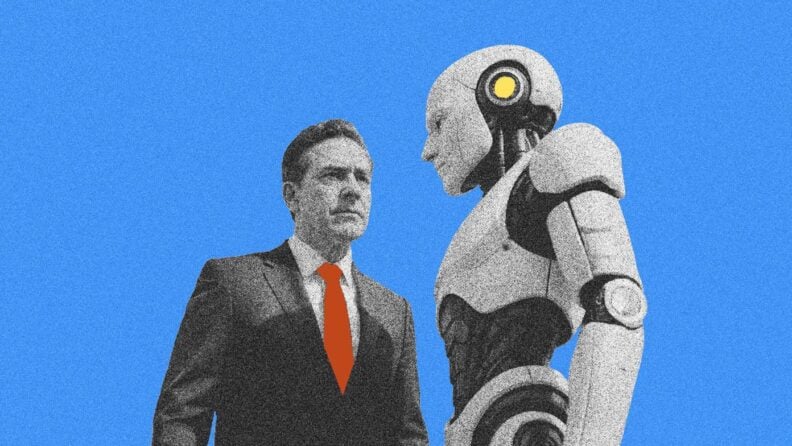Role Importance: The Chief AI Officer is pivotal for guiding AI strategy and aligning technology with business objectives.
Talent Demand: As AI roles expand, specialized talent is crucial for successful implementation and ongoing innovation.
Leadership Integration: Successful AI transformation requires collaboration between the CAIO and other executive roles, ensuring cohesive efforts.
The AI talent war is intensifying, and companies are scrambling to catch up. With 67% of mature AI organizations actively creating new AI roles, and skills shortages holding back progress, the window for gaining competitive advantage through AI leadership is rapidly closing.
Organizations that delay hiring dedicated AI leadership aren't just missing opportunities, they're ceding ground to competitors who recognized that AI transformation requires more than just new technology.
The question isn't whether your organization will need artificial intelligence, it's when you'll need someone to lead that transformation.
As AI continues to reshape industries at breakneck speed, the role of Chief AI Officer (CAIO) has emerged as one of the most rapidly growing executive positions for companies looking to stay competitive.
But timing is everything. Hire too early, and you risk creating an expensive role without clear impact. Wait too long, and competitors may gain an insurmountable advantage. So when exactly should your organization make this pivotal hire?
The Critical Signals
According to industry experts, several key indicators suggest your company has reached a threshold that demands dedicated AI leadership
"You're going to reach a certain complexity in the organization where you're trying to do a blend of working with data and trying to solve an important customer problem or an important employee problem," explains Michael Radwin, who leads AI initiatives at Verily. "You need a role like this when you've got just enough expertise and talent that you can't just squeeze these folks into your marketing organization or your engineering organization."
The tipping point often comes when organizations have six to eight people working on AI-related functions across different departments. At this stage, the need for standardized tools, career development paths, and unified strategy becomes apparent.
Technology enthusiasm without strategy
Sapir Hadad, Head of AI at Fiverr, identifies another crucial warning sign, which is widespread adoption coupled with sprawling experimentation.
"I think that people are falling in love with the technology," she said. They are trying everything, but are not necessarily thinking about the problem that we want to solve."
When your technical teams are chasing every new AI capability without clear business objectives, it's time for strategic AI leadership that can connect technological possibilities to real business value.
The AI Talent Race
The urgency around AI leadership has reached a tipping point. Despite varying organizational readiness, some experts argue that AI leadership isn't optional anymore.
"I personally think every organization needs a chief AI officer," says Ravin Jesuthasan, a transformation expert with Mercer who works with governments and Fortune 500 companies. "Every business model needs to be an AI augmented one. You don't have the option of not having a business model that is built around AI capabilities."
His reasoning is twofold: AI is no longer a competitive advantage, it's table stakes for remaining relevant. Additionally, the rapid pace of AI evolution means organizations need dedicated expertise to navigate constant change and maintain optionality across vendors and platforms.
Beyond the Chief AI Officer
While the Chief AI Officer role is increasingly important, leaders in HR and operations need to understand that AI transformation requires an entire ecosystem of specialized roles. The Gartner research reveals organizations are creating positions ranging from AI Ethicists and Model Validators to AI Cybersecurity Analysts and Prompt Engineers.
This proliferation of AI-specific roles underscores why dedicated leadership is essential. Someone needs to orchestrate this complex talent landscape and ensure these specialized functions work cohesively toward business objectives.
What Your Chief AI Officer Should Own
Team building and talent strategy
As organizations build out comprehensive AI teams, your CAIO becomes responsible for identifying which emerging AI roles your organization needs.
Whether it's AI Risk & Governance Specialists, Model Managers, or Decision Engineers, the CAIO has to understand how these specialized functions fit together and which capabilities to build internally versus sourcing externally.
Strategic vision and market intelligence
Your CAIO should have insight into how AI is evolving, understanding the landscape of tools and capabilities, and determining how they relate to your business both today and in the future.
This includes building optionality into your business model rather than becoming dependent on a single vendor's AI strategy.
User-obsessed implementation
"It's very important to be user obsessed," emphasizes Hadad. "Being obsessed about the user, the pain and the need, it's super important, because it's easy to get distracted by new technologies rather than focusing on solving real problems.”
Ethics and accountability
The role comes with significant responsibility around AI ethics, bias monitoring, and user control. As Hadad notes, "We are dealing with agents and things that can do actions for users or for us and we really need to make sure that we have accountability and ethics."
Systems thinking
Your CAIO must understand that "AI doesn't come as a standalone. It's not just the model that you're using or the agent that you develop. It's the data that is connected to it, the UX and UI. It's really building a system and not just building the best in-class agent."
What They Shouldn't Own: Critical Boundaries
While the CAIO role is expansive, clear boundaries ensure success. The position works best as part of what Jesuthasan calls "a triumvirate of operations, HR and chief AI officer, all working together" rather than operating in isolation.
The CAIO shouldn't be expected to single-handedly transform the entire organization or work independently from other executive functions. Success requires deep integration with existing operations and people strategies.
The First 90 Days: Setting Up for Success
Month 1: Business Understanding: "The first 90 days of any role starts with deeply understanding the business that you just joined and really understanding the KPIs and metrics that actually matter for the company," advises Radwin.
Month 2: Resource Assessment: Understanding existing capabilities, team structures, budgets, and technology stack provides the foundation for strategic planning.
Month 3: Gap Analysis and Socialization: Identifying gaps between current state and desired outcomes, then socializing findings with peers and leadership to ensure alignment and buy-in.
Reporting Structure: Where AI Leadership Fits
The optimal reporting structure varies by organization, according to Radwin, who reports to his Chief Technology Officer at Verily.
In smaller companies, direct CEO reporting may make sense, while larger organizations might integrate AI leadership within existing technology or business unit structures.
The key is ensuring the role has sufficient authority and resources to drive meaningful change while maintaining close collaboration with operations and human resources functions.
What Organizations Get Wrong
Underestimating the Talent Challenge: The Gartner research highlights that "a lack of skills and staff is holding many back". Organizations often focus on technology without adequately planning for the specialized talent needed to implement and maintain AI systems effectively.
Lack of Strategic Intent: Greg Vert, Human Capital and Applied AI leader at Deloitte observes that many organizations struggle because they "just start flipping switches and deploying agents" without strategic intent or clear outcome measurement.
Data Problems: Solving data quality and accessibility issues often becomes a prerequisite for AI success. "A lot of our clients don't have great data or it may be fragmented and inaccessible," notes Vert.
Leadership Role Modeling Perhaps most critically, senior leaders often fail to model AI adoption themselves. Jesuthasan shares a striking anecdote from a summit in Davos. When asking a room of CEOs how many actually use AI themselves, "10% of the room puts their hands up."
The Future
The CAIO role continues evolving as AI capabilities advance. Vert predicts exciting developments in "agentic AI" that will move beyond simple automation to deliver value-added capabilities like proactive retention management and personalized workforce development.
Organizations that establish strong AI leadership now position themselves to capitalize on these emerging capabilities while those that delay may find themselves struggling to catch up in an increasingly AI-native business environment.
Key Questions for Leadership
Before hiring a Chief AI Officer, leadership teams should honestly assess:
- Do we have enough AI-related activity to warrant dedicated leadership?
- Are our technical teams pursuing AI initiatives without clear business strategy?
- Do we have the data quality and organizational appetite for AI transformation?
- Are we prepared to integrate AI leadership with our operations and people strategies?
- Can we provide the budget and authority necessary for meaningful impact?
- Do we understand the full spectrum of AI talent we'll need, and are we prepared to compete in the current talent market?
The Competitive Imperative
With AI tools becoming increasingly available to any business with even a small tools budget, the window for competitive advantage through early AI adoption is rapidly closing.
To differentiate your organization from everyone else in the future will require creativity from the top and strong performance from people teams.
The Chief AI Officer role represents more than just a technology hire, it's a strategic investment in your organization's future. Approach this decision thoughtfully, with clear expectations and proper support structures and your teams will be best positioned to harness AI's transformative potential.
Those that treat it as merely another new technology to implement risk falling behind in the AI-driven economy.


